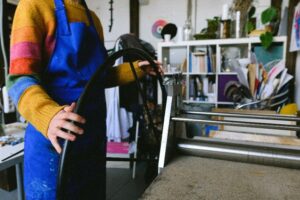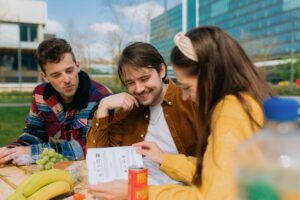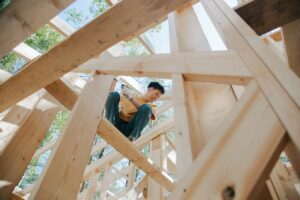With increasing skepticism towards tech-development that puts society, public goods and the environment at risk, policy makers and universities are looking for new ways forward. To tackle problems in more collaborative and democratic ways, co-creation is regarded as a potential cornerstone in this transformation. The promise of co-creation includes grounding innovation in actual societal concerns, mindful of welfare, sustainable development, and inclusion. But what does co-creation in engineering education look like, and how can we foster good relationships between students, teachers, and societal actors?

Co-creation in engineering education is a rather new concept and has rarely been investigated systematically. The concept’s origin is often traced back to the business world, where co-creation meant a shift from viewing the customer as passive recipient of products, to seeing them as active agents in product development (Prahalad & Ramaswamy, 2000). After 2000, the term co-creation, often used interchangeably with co-production, has increasingly received attention outside the business world amongst academics and public management (Verschuere et al., 2012). New areas of application beyond commercial issues are seen in the co-production of public welfare, policies, and sustainability transitions. At the same time, demands towards universities to reach mutually beneficial solutions with society have increased (Pulkkinen & Hautamäki, 2019), which points to the growing need to co-produce solutions between university and civil actors.
For our project, we were inspired by a definition of co-creation from the SCALINGS project. Here, co-creation is defined as “an opportunity for making innovation processes more socially inclusive and responsible because it allows innovators to integrate diverse actors into the innovation process” (p. 2).
This history influences how we think and practice co-creation in engineering education. Students are not seen as passive recipients of education, but as enablers of broader sustainable development, where interaction with and for society is central. Our goal within BoostEuroTeQ is to enable individuals in technology value creation to interact with stakeholders of wider society. We support engineering education in which students can actively shape a meaningful and impactful societal transformation. To understand how we can best contribute to those goals, we examined if and how co-creation is already practiced at our partnering universities.
Our ethnographic fieldwork took place in 2022 in 15 courses across the partner universities, where 31 students, 8 teachers and 9 professionals from teaching and learning units participated in interviews, with additional participant observation in selected classes. When choosing courses, we looked for criteria inspired by the above-mentioned SCALINGS project. Based on this fieldwork, we found out what characterizes co-creation-inspired teaching across our universities, and got an idea of what is needed for “good practice”.
Co-creation in engineering education includes collaboration around a real-life case. As opposed to solving an imagined case or theoretical problems, students engage with an actor outside of university, such as an NGO, company, or civil society group, who present a problem that is relevant for them. Such problems for instance deal with reducing carbon emissions on an energy island, the design of mobility systems for rural communities, or how to improve leisure activities for people with disabilities. For creative co-creation to happen, complex problem framing is required, which means that the case is open-ended and addresses different levels, including for instance environmental and economic factors, but also aspects like psychology and behavioral design. Thinking through such multiple levels is new to many students, and they often mention the feeling of “thinking outside the box”.

I learned that the real-world problems do not have specific solutions. Because problems and homework at university usually have some specific solutions. And you either do it right or do it wrong. But when you have a real-world problem, you need to assume some stuff and try something and try if it could work. And it’s, it’s a little bit different.
― CTU student
As part of the partnership with different actors, students engage with different forms of expertise. Such engagement could entail consulting those users or citizens who will potentially be affected by an innovation, people who have lived experience with a technology, scientific experts, or other knowledge sources, such as websites or magazines. For engineering students who often are trained to be domain-specific experts, such openness to dialog with a variety of actors comes with new challenges. Things are messier when “real people” are involved, and initial problem formulations might need to be reconfigured due to new insights. Therefore, dedicated time & space for proximity-seeking activities is essential, as students benefit from immediate, direct contact with involved actors.
We observe that student’s experience in co-creation-inspired courses relies on a different form of project ownership and emotional experience, which is different to widespread primarily cognitive, intellectual involvement in traditional classes. This different way of experiencing education is related to the dialogical engagement with co-creators. During group work, students practice listening and communication skills, but also deal with discomfort when engaging with different perspectives. In so doing, students work through different value-systems and explore different biases, norms, and beliefs. The following student expresses this collaborative experience in the team as follows:

We are a multiracial, multinational, multi everything team. If we didn’t have the right ethics and we didn’t have some sense of humor about this, we would never be able to collaborate with each other. It’s 100% needed within any team to understand different cultures, different people, and we should accept each other. In my culture it’s not ethical to do that, but in his culture it’s ethical.
― TalTech student
We see that co-creation is not a dry experience; it requires emotional maturity to see that the ”right” approach can look differently across cultures. But there also needs to be a suitable setup for such encounters, and enough time for discussion. To help set the scene, teachers often encourage students to think broader than their study lines so that students can show up with their full self when interacting with others.
Co-creation takes place in a special pedagogical setup; the teacher is a “scaffolder” or coach in the learning journey. Giving space for student creativity and being there as partner is key. Different to the classic lecture format, where replication of knowledge is seen as the central way of learning and evaluation, theoretical input is transferred in a way that makes theory easy to apply in practice; that could be learning about the ethics of user engagement, followed by first-hand experimentation with such; or learning about team roles, followed by experimentation with such in your group. A special mixture between theoretical and hands-on sessions is key. A teacher puts it like this:

The most important thing is that it’s a hands-on learning experience. They have to try it. Giving lectures about co-creation isn’t the same thing as trying it out. Of course, you have to do lectures as well. But intertwine it with them actually being able to plan and facilitate workshops because learning from experience usually brings much more into the brain than just hearing about something.
― DTU teacher
This implies that activities in co-creation inspired courses are often more decentralized compared to the single-sided classroom teaching. Consequently, different facilities are needed for co-creation education, and teachers need to move between frontstage and backstage presence. For such a more decentralized setup to work, it is important that students still have orientation and guidance. Part of the pedagogical setup are therefore methods for exploration and reflection. Methods for co-creation allow students to have allocated time to explore different perspectives and get feedback from others, but also provide them with a clear indication of the different stages in the co-creation process. There is no uniform “co-creation model” across the EuroTeQ alliance, but we found different methods which usually allow for an explorative phase, a narrowing-down phase and enough time for feedback and revision of problem formulations.
Since co-creation is indeterminate by nature, there often isn’t a clear right and wrong answer. Therefore, multiple-choice exams as only form of assessment aren’t used. Instead, several types of evaluation on the process and product dimension are required to capture the full experience. Complex learning goals and multi-layered evaluation are therefore another part of co-creation teaching.
Quotes have been slightly adapted for readability.
This project is funded by the EU, Horizon2020. The full report can be found here.
References:
- Prahalad, C. K. & Ramaswamy, V. (2000). Co-opting Customer Competence. Harvard Business Review, 78(2), 79–9.
- Pulkkinen, K. & Hautamäki, A. (2019). Co-creation with Companies: A Means to Enhance Societal Impact of University Researchers? Introduction: Problems and Solutions in Co-creation. In M. P. Sørensen, L. Geschwind, J. Kekäle, & R. Pinheiro (Eds.), The Responsible University (pp. 145–171). Palgrave Macmillan. https://doi.org/10.1007/978-3-030-25646-3_6
- SCALINGS @ Munich Center for Technology in Society. (2021). Co-creating European Futures. Innovation, Participation, Co-creation. Europe 2030.
- Verschuere, B., Brandsen, T. & Pestoff, V. (2012). Co-production: The State of the Art in Research and the Future Agenda. Voluntas, 23(4), 1083–1101. https://doi.org/10.1007/s11266-012-9307-8







